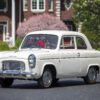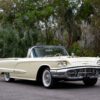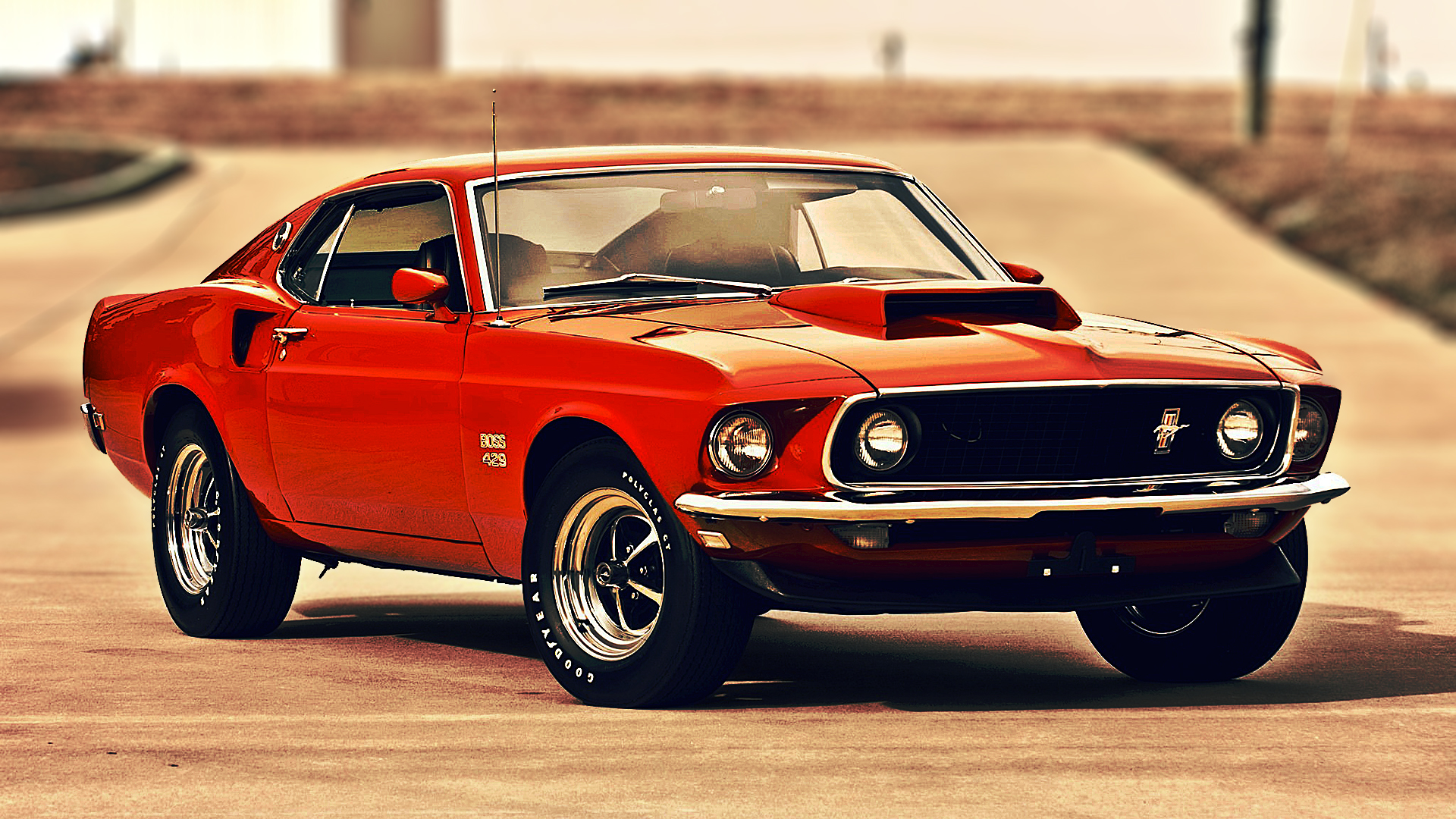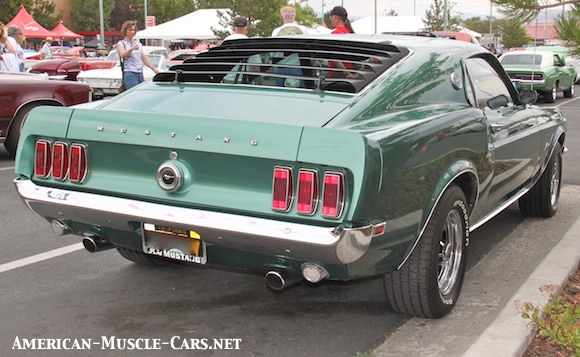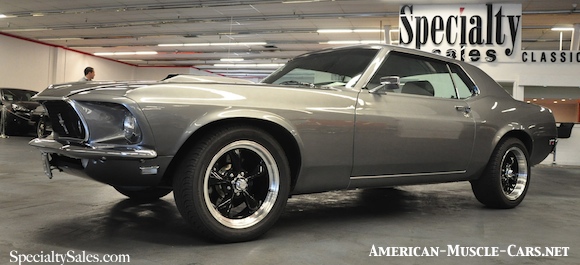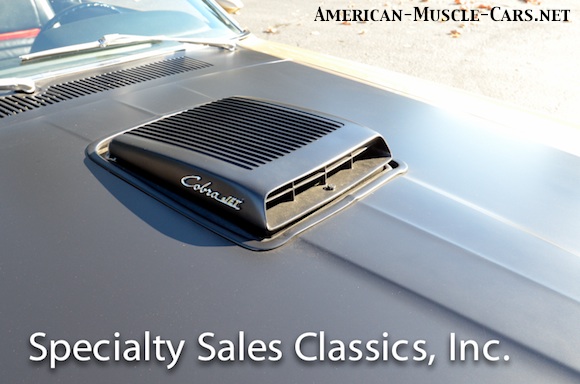1969 Ford Mustang

1969 FORD MUSTANG GETS A SLEEK NEW LOOK
1969 was a big year for the Ford Mustang. A whole new body skin (over the existing chassis) yielded a lower, sleeker, leaner, meaner looking car. It actually grew in length, although on the same 108-inch wheelbase as before, but got lower. First off, all ’69 Mustangs sat about 1/2-inch lower on their suspension. But then they dropped the roof down another .9-inch on the new Fastback body style, which was renamed “Sport Roof”. This became a much more popular and prevalent body style, accounting for some 44% of all Mustangs sold in 1969, a huge percentage increase over previous years. The windshield rake angle was also increased by 2.2 degrees, giving it a more aerodynamic appearance. All this growth and these changes added up to about a 150 to 175 pound weight gain over the 1968 Mustangs.
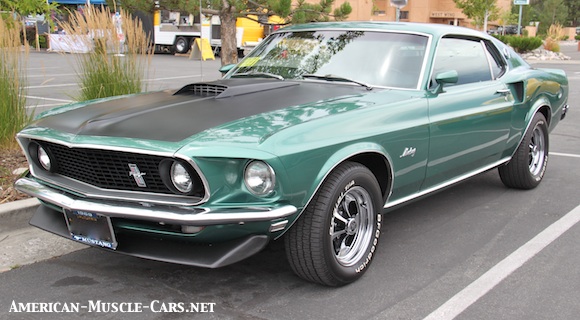
1969 Ford Mustang SPORT ROOF
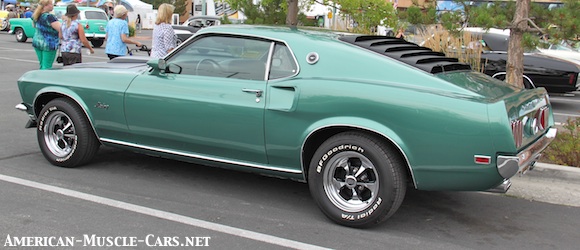

1969 FORD MUSTANG STYLING CUES
All 3 body styles, Hardtop, Convertible and now Sport Roof (formerly Fastback, formerly 2+2), got a more aggressive look up front with a larger grille opening and a generally forward-leaning stance that made it look ready to pounce. The ’69 had a 4-headlight treatment with the 2 outer beams molded into the front corners of the fenders, as normal, and the inside set recessed into the grille opening. It gave it an endurance-racer look. The back end continued the concave tailight panel, but did a better job of it, and the Sport Roofs all came with a ducktail, or flip-up rear spoiler. The Sport Roofs got a small but very prominent faux side scoop high up on each rear quarter just aft of the door handles that flowed from the horizontal body line that originated at the front of the car. It was a cool look, but it was gone by 1970, and it wasn’t used on the Boss 302s. But for all the new bumps and lines, the new 1969 left no doubt that it was a Mustang, carrying on and evolving many of the classic Mustang styling cues that people came to expect in a Mustang. Ford really got it right, and many think, myself included, that the 1969-1970 Mustang Fastbacks (Sport Roof) were the best-looking Mustangs ever, before or since.
1969 FORD MUSTANG EXTERIOR OPTIONS
There was now an option package called the Exterior Decor Group that included rock panel moldings, wheelwell and rear facia moldings and a 5-spoke wheel cover.
1969 Ford Mustang CONVERTIBLE
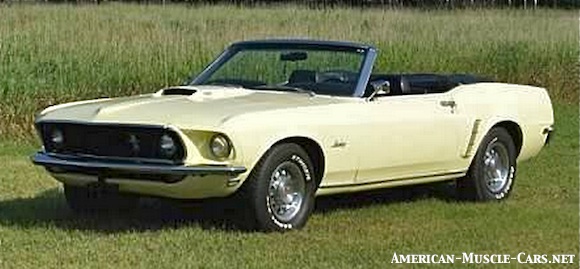
1969 Ford Mustang HARDTOP
1969 Ford Mustang INTERIORS
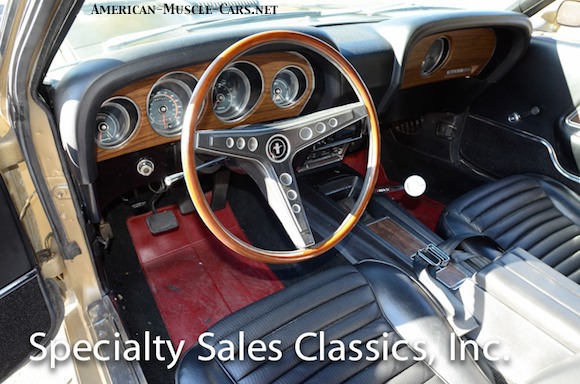
1969 FORD MUSTANG INTERIOR OPTIONS
Virtually everything was changed inside, yet managed to retain that classic Mustang ‘double-cowl’ look to the dash. There was a new option package called the Deluxe Interior Decor Group, optional on all Convertible and Sport Roof Mustangs (not Hardtops), and standard on the Mach 1, Boss 429 and the Grande. It included simulated woodgrain appliques on the dash, doors and console and a clock, which faced the passenger but was hard to see from the driver’s seat. Another interior option package was the Interior Decor Group which consisted of Comfortweave-upholstered seats, molded door panels with wood appliques, the 3-spoke “Rim-Blow” steering wheel (called that because you honked the horn by squeezing the rim of the steering wheel), and a remote-controlled rightside rearview mirror.
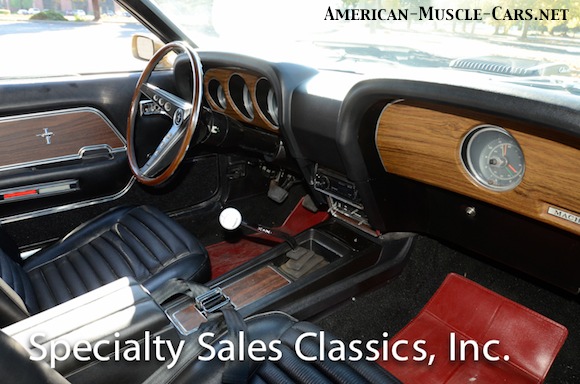
1969 FORD MUSTANG DASH & GAUGES
The new Mustang came with a 4-pod gauge cluster with two large dials inboard, strattling the steering column, and two small dials outboard, one on each side. On standard cars, the left-center dial was the speedometer, the right center dial was shared by the fuel and temperature gauges, the outer-left dial was the alternator gauge and the outer-right the oil pressure gauge. If you ordered the optional tachometer package, everything had to be reshuffled. The speedo was the only instrument to stay put. The tach now resided in the center-right position, displacing the fuel and temperature gauges. The fuel gauge moved to the far-right position, and the temp to the far-left. This left the alternator and oil pressure gauges without a home. Interior lighting was optional, as were intermittent windshield wipers and power ventilation.
1969 Ford Mustang MACH 1
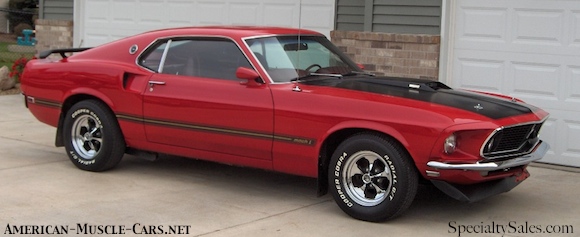
1969 FORD MUSTANG MACH 1
The Mach 1 took the place of the Mustang GT as the top performance variant, although the GT continued to be sold as the ‘no-flash‘ version. The new Mach 1 was festooned with stripes, scoops, spoilers and a blacked-out hood to give it that ‘boy-racer’ look. And it really looked the part. A 1969-1970 Mach 1 is still a very handsome car today. There was a faux hood scoop similar to that found on the ’68 Mustang 428CJ. To further emphasize its racing ambitions, there were also optional NASCAR-style hood hold-down pins. The stripes were reflective, and there were a special flip-open gas cap, styled steel wheels, and chromed quad exhaust tips. The Mach 1 was one of the first production cars to have body-colored dual racing mirrors standard. The Shaker Hood was also a first. (The following year, Chrysler would follow with a shaker hood of their on on the Challenger-Cuda twins, and Pontiac did the same for the 1970 Trans Am). Mustang’s Shaker Hood was only available on 390s and 428s. All Mach 1s came with the Deluxe Interior Group with Rim-Blow steering wheel, center console, high-back bucket seats and 55 pounds of sound deadening. The standard engine for the Mach 1 was now a 2-barrel 351W, with more powerful V8s optional.
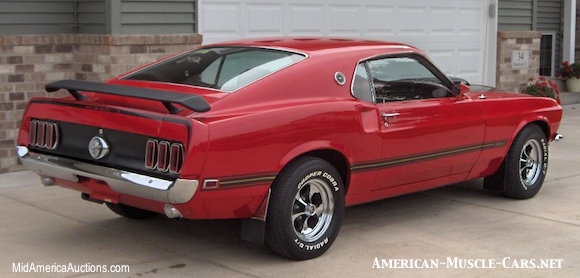
1969 FORD MUSTANG GT
What? A ’69 GT? Yep. Ford built 4,973 of them in all 3 body styles to cater to those who wanted the performance without all the glitz and glamour of the new Mach 1. The GT Equipment Group consisted of rocker panel stripes, GT gas cap, GT center caps on styled steel wheels, dual exhaust with chromed quad tips (4-barrel cars only), and NASCAR-style hood pins. All the engine options available to the Mach 1 could also be ordered on the GT, all the way up to the top-line 428SCJ.
1969 Ford Mustang ENGINES
Please visit our FORD ENGINES-section
1969 FORD MUSTANG POWERTRAIN OPTIONS
The base Mustang powertrain was still the ancient 200ci six mated to a 3-speed manual transmission with floor shift, but you could option up to the 3-speed Cruise-O-Matic automatic. There was also a larger 6-cylinder now, the 250. The extra power allowed air conditioning to be ordered, heretofore unavailable on a 6-cylinder Mustang (you still couldn’t get AC with the 200). The smallest V8 was now the 302, and the base version with 2-barrel carburetor was rated at 210hp. From there, it jumped up to 2 versions of the 351W (Windsor) V8. One more wrung up the ladder got you a 390 big block. Then the real performance cars started. There was the Boss 302, which had a very different engine than the civilian 302. Next up was the 428CJ (Cobra Jet), topped by the ultimate Mustang engine, the Boss 429. Good thing too, with Chevy dropping 427 big blocks into Chevelle SS and Camaros (via COPO), and the 454 on the way. Things were heating up fast in the Muscle Car Wars. Little did anyone know at the time that the end was barely a year away.
1969 FORD MUSTANG ENGINES – A PLETHORA OF CHOICES
There is some confusion out there about the different Ford engines that were running around, at about this time. There were 2 distinctly different 351s from different engine families, the 351C and the 351W. There were 2 different 302s, the standard 302 small block and the Boss 302. Ford also had a family of FE big block V8s in with four engines all within inches of each other, the 427, the 428, the standard 429, and Boss 429. It was crazy. And it was confusing. We will attempt to shed some light on it, if we can.
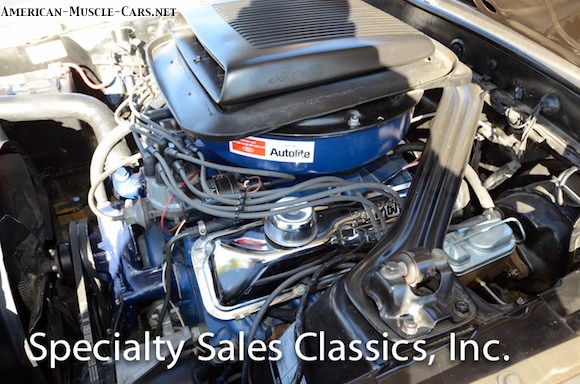
1969 FORD 351 WINDSOR (351W)
The 351W and all Windsor small block V8s were built in Ford’s Windsor Engine plant in Ontario, Canada, hence the name. The 351C was built in their Cleveland OH plant, hence that name. The 351W was essentially a 302 small block stroked to 3.5 inches with the deck raised one inch to accommodate the longer stroke. Lengthening the stroke changes the bore-to-stroke ratio, making it more “undersquare”, which generally means it won’t rev as freely as a more “oversquare” engine. The crank journals were also enlarged, making most of the engine non-interchangeable with the 302. Only the heads were the same, except with slightly larger ports. The 351W with 350cfm 2-barrel Autolite carburetor made 250hp. The 4-barrel version used a 470cfm Autolite 4-barrel and made 290hp. While the beefing up made the bottom end almost bullet proof, the small ports and valves and the long stroke limited the 351W’s performance, and what there was of it was only available at low and mid-range revs. The 351C was still a year away, but it would run circles around a 351W.

1969 FORD MUSTANG 428 COBRA JET
Introduced in the 1968 Mustang, the 428 Cobra Jet engine was the top engine until the Boss 429 came out. The 428CJ was available in 3 flavors. The first had a non-functional hood scoop. The second, a $133 option over the base 428CJ, added the Shaker Hood with functional cold air induction known as the 428 Cobra Jet Ram Air, and included a flapper valve that opened upon flooring the gas pedal, to allow cold outside air into the air cleaner housing. It improved quarter mile times by .2 seconds and added 2mph to the trap speed. It was called a Shaker Hood because the scoop was mounted directly to the top of the engine, extending through a hold in the hood, so that when the engine shook, the scoop shook with it, which was very obvious when it was sticking up through the middle of the hood. The third 428CJ option was known as the Super Cobra Jet Ram Air (429SCJ), which got you lower rear end gearing, 3.91:1 (axle code V) or 4.30:1 (axle code W), and special connecting rods similar to the racing 427s, for high rpm work. The SCJ also got an engine oil cooler which lowered engine oil temperature by 30 degrees. 428CJs were famous for their low-end torque and tended to shred their undersized F70X14 tires, but could still run the quarter mile in the high-13s to mid-14s.
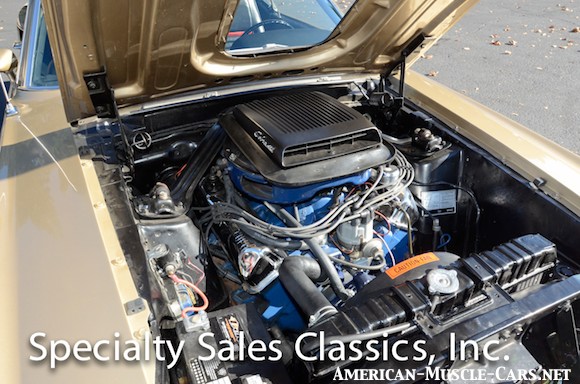
1969 Ford Mustang 428 COBRA JET
1969 FORD MUSTANG 428 COBRA JET
Introduced in the 1968 Mustang, the 428 Cobra Jet engine was the top engine until the Boss 429 came out. The 428CJ was available in 3 flavors. The first had a non-functional hood scoop. The second, a $133 option over the base 428CJ, added the Shaker Hood with functional cold air induction known as the 428 Cobra Jet Ram Air, and included a flapper valve that opened upon flooring the gas pedal, to allow cold outside air into the air cleaner housing. It improved quarter mile times by .2 seconds and added 2mph to the trap speed. It was called a Shaker Hood because the scoop was mounted directly to the top of the engine, extending through a hold in the hood, so that when the engine shook, the scoop shook with it, which was very obvious when it was sticking up through the middle of the hood. The third 428CJ option was known as the Super Cobra Jet Ram Air (429SCJ), which got you lower rear end gearing, 3.91:1 (axle code V) or 4.30:1 (axle code W), and special connecting rods similar to the racing 427s, for high rpm work. The SCJ also got an engine oil cooler which lowered engine oil temperature by 30 degrees. 428CJs were famous for their low-end torque and tended to shred their undersized F70X14 tires, but could still run the quarter mile in the high-13s to mid-14s.
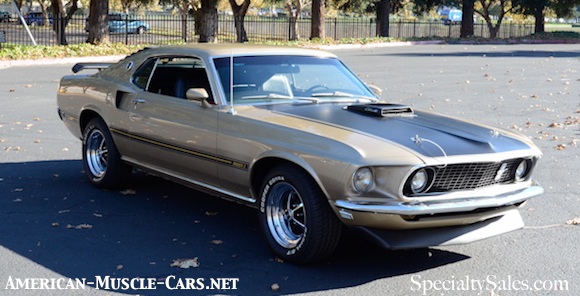
1969 Ford Mustang BOSS 302
1969 FORD MUSTANG BOSS 302
The Boss 302 was motivated by Ford’s desire to compete in the SCCA (Sports Car Club of America) Trans Am racing series, in which Pony Cars competed with factory backing, but engines could not exceed 5.0 liters in displacement. Chevy fielded the seminal 1969 Camaro Z28 with the high-winding DZ302, and across town Mopar readied their new-for-1970 Dodge Challenger T/A and Plymouth Barracuda AAR, both with small blocks that met the rules. Pontiac even came out with a car named the Trans Am, but ironically it couldn’t qualify to run in the Trans Am series because its engine was too big. But everyone was cashing in on the Trans Am series by building production car-versions of their racers, which also satisfied SCCA’s ruling that a minimum of 1,000 units be sold to the public, establishing it as a ‘production car’, and Ford wanted some. They developed the new Boss 302 engine specifically to compete in the series, after the Tunnel Port 302 proved unreliable. It was civilianized for the production version.
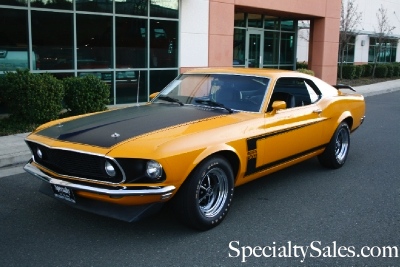
1969 FORD MUSTANG BOSS 302 BODY,BR> The body would be the Sport Roof (Fastback) only, with the side scoops removed to clean up the lines, a front spoiler, and the hood, headlight coves, rear deck and taillight panel were blacked out. There was a unique C-stripe with its broad vertical component angled slightly forward on the front fender, and it’s two legs running back along the door, with a big “BOSS 302” emblazoned on it. All in all, it was a great-looking package. It was only available in 4 colors: Wimbledon White, Bright Yellow, Calypso Coral, or Acapulco Blue. The Boss came with argent-painted Magnum 500, with chrome as an option.
1969 FORD MUSTANG BOSS 302 MECHANICALS
On the functional side, the front shock towers were reinforced and larger wheel spindles were used in front, to counter the higher cornering loads the car could generate. Unlike the GT or the Mach 1, the Boss 302 was a complete package with relatively few choices to make. It came with one engine, the Boss 302 V8, mated to just one transmission, a wide-ratio 4-speed manual. Front disk brakes and quick-ratio steering (16:1) were standard as was a 3.50:1 rear axle ratio (3.91:1 and 4.30:1 were optional). Staggered shocks (one in front of the rear axle, one behind) helped mitigate the vicious wheel hop that this much power could generate. The fenders were radiused to help clear the wider F60 tires.
1969 FORD MUSTANG BOSS 302 ENGINE
But what really made the Boss 302 special was its engine, the Boss 302 V8. Ford started with the 302 small block, strengthened it, added 4-bolt main bearing caps, a forged steel crankshaft and connecting rods. Redesigned cylinder heads had huge intake and exhaust ports, large, angled valves (2.23” intake and 1.72” exhaust) actuated by adjustable rocker arms. An aluminum high-rise intake manifold mounted a 780cfm Holley 4-barrel carburetor. The cam was sort of a “street & strip” grind with mechanical lifers, which spun a dual-point distributor. With dual exhaust helping it breathe well, this was an engine that loved to wind. Ford installed a rev-limiter to protect it from over-revving, which put a halt to the festivities at 6,150rpm. Without it, the Boss 302 would routinely rev to 7,000rpm with momentary bursts to 7500rpm. It was rated at a conservative 290hp at 5,800rpm and would do the quarter-mile in the high 14-second range, and do 0-60 in less than 7 seconds. But they weren’t just fast, they also handled well, for the times at least. A Boss 302 placed second in the 1969 Trans Am Series, and won it in 1970.
1969 Ford Mustang BOSS 429

BUILDING THE 1969 FORD MUSTANG BOSS 429
The Boss 429 may well be the ultimate Mustang, or at least the ultimate high-performance Mustang (modern high-performance Mustangs notwithstanding). It’s easy to see why. First off, it was built in small numbers on a special series production line, similar to the way the early Shelby’s were hand-built. And there was much more to the Boss 429 than simply dropping a monster motor into a Mustang body. The Boss 429 was meant to satisfy NASCAR homologation rules (building a certain number of production versions and selling them to the public), similar to what Chrysler was doing with the Hemi-powered Superbird and the Charger Daytona. Ford needed to build 500 cars to meet the rules and the deadline was looming. It would have been easier to fit the enormous 429 engine into a Torino body perhaps, but the decision was made to shoe horn it into the Mustang, even though the engine compartment had to be heavily modified to make it fit. Ford subcontracted this job out to Kar Kraft. Ford shipped them brand new 1969 Sport Roof Mustangs, partially assembled, with some things installed and some things left out. From there Kar Kraft moved the front shock towers outward and reinforced, which necessitated the moving of the lower suspension mounting points outboard by about an inch.
1969 FORD MUSTANG BOSS 429 STYLING CUES
Unlike the Boss 302, the Boss 429 still had the faux side scoops, and it sat slightly lower in front, due to the extra engine weight and the new suspension geometry. They came stock with chromed Magnum 500 wheels with Goodyear F60X15 tires. Only one interior was available on the Boss 429, the Deluxe package with center console, 8,000rpm tachometer, Rim-Blow steering wheel and 55 pounds of sound-deadening. They came in 6 colors: Raven Black, Black Jade, Royal Maroon, Candy Apple Red, Wimbledon White and Blue. The stripe graphics were about the same as the Boss 302, but with Boss 429 on them instead.
1969 FORD MUSTANG BOSS 429 MECHANICALS
All Boss 429s came with engine oil coolers, a trunk-mounted battery (to help offset the weight of that massive engine in front), power disk brakes, power steering, close-ratio 4-speed manual transmission, staggered rear shocks, heavier springs, bigger front sway bar (15/16”), 3/4” rear sway bar (the first car to have one) and 3.91:1 Traction-Lok rear end (with 4.30:1 Detroit Locker optional).
1969 FORD MUSTANG BOSS 429 – THE ENGINE
The Boss 429 V8 engine was coded 429CJ-R HO on the drivers door, but it went my a wide range of wild names: “Blue Crescent 429”, “Shotgun 429”, and the “Twisted Hemi”. This engine was unique to the Boss 429, it was never used in any other application. It was essentially a set of very special aluminum heads mounted on a cast iron 429 block. While similar in appearance to the civilian 429 and 460, the Boss 429 was cast in nodular iron and was much stronger. It had a unique four-gallery oiling system, 4-bolt main bearing caps, and extra-thick cylinder walls that could be overbored by as much as 0.160 inch. There were a forged steel crankshaft and connecting rods and 10.5:1 compression pistons. The aluminum heads had a modified hemispherical combustion chamber with huge valves and ports. The intake valves were 2.28” and the exhaust valves were 1.90”, arranged in a cross-flow position, optimized for high flow at high rpms. The aluminum had was mounted “dry deck”-style, with no conventional head gasket, only copper O-rings for each cylinder, and rubber Viton rings on all water and oil passages. A Holley 735cfm carburetor, a mild hydraulic cam, aluminum high-rise intake manifold, low-restriction exhaust manifolds, a dual-point distributor, and a 6-quart old pan rounded out the package. There were 2 versions of this engine, coded “S” and “T”. S engines had larger connecting rods, with 1/2” bolts (each weighed almost 3 pounds!) like the ones used on the NASCAR engines. The more common T engines used more normal rods. They were both rated at 375hp at 5,200 rpm, which sounds very low, both the output, and the rpm at which they read it. This was often the trick they used to understate the horsepower. It may produce 400hp at 5,800 rpm, but they only ran it up to 5,200 to get the lower reading. Who knows. I’ve ridden in one, and they feel faster than that.
1969 Ford Mustang PRODUCTION NUMBERS
| 1969 FORD MUSTANG
2-door Sport Roof 2-door Sport Roof Deluxe 2-door Sport Roof Mach 1 2-door Hardtop 2-door Hardtop Deluxe 2-door Hardtop w/Bench Seat 2-door Hardtop Deluxe w/Bench Seat 2-door Hardtop Grande Convertible Convertible Deluxe |
CODE
63A 63B 63C 65A 65B 65C 65D 65E 76A 76B |
QUANTITY PRODUCED
56,022 5,958 72,458 118,613 5,210 4,131 504 22,182 11,307 3,439 Total 299,824 |


